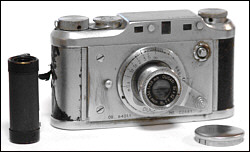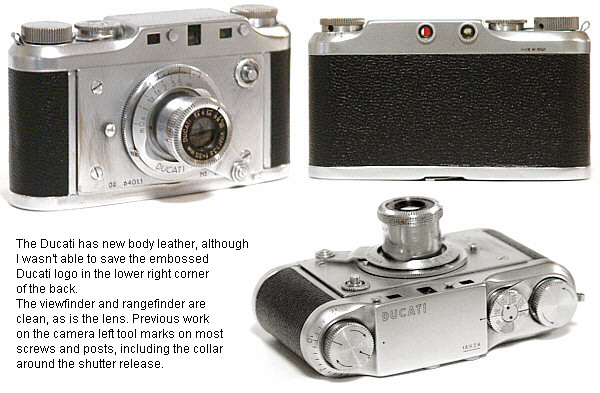The Ducati Sogno: Miniature Elegance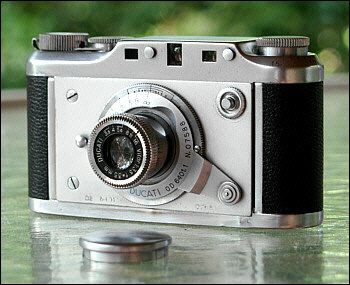 The Ducati rangefinder was made by the famed Italian motorcycle manufacturer of the same name in the mid-1940s. The adage is that good things come in small packages. Spending a day with a Ducati Sogno (Dream) rangefinder camera will make you believe that. 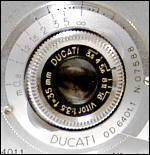 The uncoated Vitor lens is nearly flush with the front of the body when collapsed. I've seen photos of the Ducati, and it didn't dawn on me just how physically small the camera is until I held one in my hands. It's 3 3/4 inches wide, 2 1/8 inches tall and just under an inch deep. Even for a half-frame camera, that's small. But even more surprising is its weight. I don't have a postal scale, but it has significant weight because of the prolific use of steel, brass and glass. The Ducati is often compared to a Leica, but that is like comparing a Ferrari with a VW Jetta. They're both cars, but that's where the similarity ends. The Ducati and Leica are both rangefinders with cloth focal-plane shutters, but both cameras then take different paths. Much of the Ducati is reversed, possibly because engineers tried to pack as many features into the camera as possible. The list is impressive: Rangefinder focusing, interchangeable lenses, diopter adjustment, use of standard 35mm film and a focal plane shutter. The standard lens is the 35mm Vitor. There were two known variations of this lens: f/2.8 and f/3.5. I have the f/3.5 version. The knurled front of the lens allows the photographer to change the aperture down to f/16. 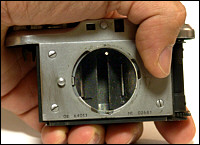 The barn doors open just before the shutter curtains are released. Shutter speeds are a bit limited on the low end, running from 1/20 to 1/500 plus B. There are no slow speeds. Ducati went to extra effort to prevent the photographer from taking a photo without the lens extended or with the lens cap still on the camera. As Rick Oleson notes in his writeup, the camera uses two barn doors in front of the shutter that won't open as part of the shutter release sequence unless the lens is extended. That prevents the shutter release from being fully depressed, which fires the shutter. Furthermore, you can't grasp and extend the lens without removing the lens cap. Sort of ingenious. You can still do dumb things, like extend the lens and replace the cap, but this should cut down the frequency of shooting blanks. And with just 15 shots per roll, you'll want to make every shot count (not that you shouldn't do that anyway). The rangefinder 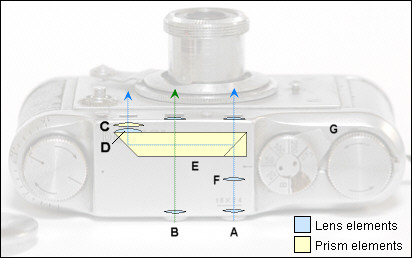 How
it works How
it works• The photographer looks through viewfinder (A) and focuses the lens, which slides wedge prism (C) left or right to bring the scene into focus by aligning the two coincident images. A magnifying element (D) is fixed to the main prism (E) and enlarges the rangefinder base. • The photographer uses viewfinder (B) to compose the shot, peering through the middle of the main prism (E). • A small lens (F) mounted in a tube slides forward or backward by moving the diopter adjustment lever (G). With a camera so small, accurate focusing is a must. The Ducati uses a coupled rangefinder system that is very similar to what you'll find in a Contax -- except in reverse, of course. It uses a swinging wedge prism to achieve coincidence focus. The Ducati has two viewfinders -- one for focusing and one for composing. The eyepieces are tiny -- really tiny, and are very difficult to use in low light. Now that the image is in focus, all that's left to do is to release the shutter. The release is on the front panel (just below C) in the drawing above, usually operated with the index finger of the left hand. It's smooth but requires moderate pressure.A small translucent red flag appears in the viewfinder when the camera hasn't been advanced and after the shutter is released. It slides out of the way when the film is advanced.Film transport The Ducati uses special film cassettes that hold enough film for 15 exposures (that's 7 1/2 regular 35mm frames). The cassette is roughly the same diameter as a AA battery, although not quite as high. The film spool has an even smaller diameter. Film is held in place by a spring clip. The same applies for the takeup spool. It's slightly larger in diameter and also has a spring clip. Small nubs near the ends of both spools grasp the film sprockets. The camera has a left-hand wind and right-hand rewind. Advancing the film also tensions the shutter. Pulling up on the film-advance knob releases the takeup spool and allows the film to be rewound. Like many European cameras from that time, the back is removed when changing the film. In this case, the back is really the rear part of the body shell. It uses a tongue-and-groove design to mate to the lens panel, and is latched using a small lever on the baseplate. Obviously, being a European camera, there is no foam necessary to block light. There is no provision for flash synchronization, and because the camera lacks slow speeds, it isn't the best camera for low-light photography. Not that it can't be done, but coupled with a tiny viewfinder. there are other cameras better equipped for these situations. Field report  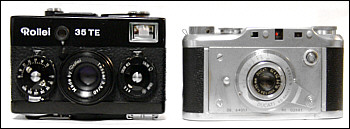 Top: The Ducati is barely taller than a roll of 35mm film. Middle: It's shorter than a Rollei 35 TE Below: Next to a Retina IIIc, a "normal sized" classic camera from the same era. 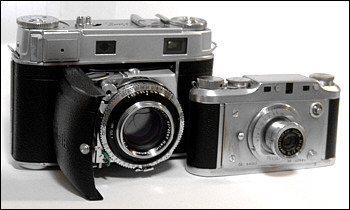 Coming to grips with a camera this small entails a bit of dexterity and maneuvering and some practice as well. The Ducati isn't only small when it comes to its body, but all of its parts are small as well. Plus, there's the added fear of dropping a true collectible. The first challenge was loading the film. As can be seen in the photo below, the film cassette is tiny. My eventual method was to bulk load a standard 35mm cassette with 9 photos, then connect the small film leader to the Ducati spool. In a changing bag, I then respooled the film onto the Ducati spool, slid it into its cassette and capped it. The film leader needs to be trimmed on the sides, so it properly catches nubs on the takeup spool. With the Ducati loaded, I found that advancing the film with my left hand while feeding it with my right hand took some of the stress off the advance and therefore the film itself. I tended to use both middle fingers to focus the camera in a pushing to-and-fro movement. That seemed to work nicely. You have to take your time with the Ducati, because of the need to use two viewfinders (like a Leica) and also because you often are taking the camera from your eye to search for the shutter release or to reposition it in such a way that your thumb doesn't prevent you from seeing through the viewfinder or making sure your finger isn't covering part of the lens. I was mostly shooting at 1/20 and 1/50, and the shutter fires smoothly with a very satisfying sound. The rangefinder is dim because of problems I describe below. If you take your time with the Ducati, you'll find it to be a fun camera to use. Restoration notes This camera was in poor condition, which I knew before I had purchased it. I was hoping that it didn't look as bad as the photo indicated, but that wasn't true. It was as bad as it looked. Because the Ducati is an uncommon camera, I bought it anyway. The first pleasant surprise was that it included the film cassette. I had thought I might be able to make one myself, and I still might tackle that. But now it wasn't a necessity. This particular Ducati was missing a good bit of its leather. The viewfinder and rangefinder were almost completely occluded by grime. The lens was missing one of its stop screws, and the lens simply unscrewed from the mount. Someone had relocated the 1/500 speed on the selector dial and in the process ground off the first marker. There were numerous scratches on the front of the camera. There was a nasty dent on the one side and some smaller dents on the corner of the bottom plate -- evidence that the camera had been dropped. Restoration was easy enough. The shutter was running OK, so I haven't done much with it, other than to remove the immense amount of dust that was in that region, as well as the rest of the camera. I pounded out the dent on the side of the camera, cleaned the viewfinder system and replaced the missing stop post for the lens. There remains some haze on the inner lens surfaces, and there is some oil on the aperture blades -- the next project, perhaps. There is moisture damage that seeped into the two balsalmed prisms, and nothing can be done with that, short of separating and re-balsalming the prisms. The result is a dimmer-than-normal rangefinder. I'll live with it for now. I faced a dilemma when it came to replacing the leather: Leave it in its current state, which looks terrible, or replace it with something else and lose the Ducati embossing on the back. Eventually, I decided to replace the leather, which meant stripping off the old material and the adhesive and reattaching a new piece. I'm very pleased with the results.
|
